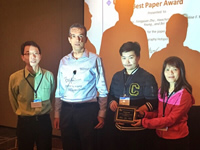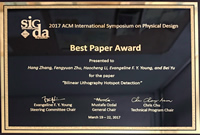Congratulations that Mr. ZHANG Hang, Mr. ZHU Fengyuan, Mr. LI Haocheng, Prof. YOUNG Fung Yu, and Prof. YU Bei won the Best Paper Award at ACM International Symposium on Physical Design (ISPD 2017, see http://www.ispd.cc/?page=awards). The paper entitled “Bilinear Lithography Hotspot Detection”.
ISPD is the Association for Computing Machinery’s International Symposium on Physical Design, which specializes in critical areas related to the physical design of VLSI systems. The annual ISPD conference is one of the most prestigious conferences in physical design research. It is a leading international symposium for physical design researchers, practitioners, developers, and users to explore cutting-edge ideas and results, and to exchange techniques, tools, and experiences. The best paper award recognizes the highest quality paper at the conference.
Paper Link: http://dl.acm.org/citation.cfm?id=3036673
Abstract:
Advanced semiconductor process technologies are producing various circuit layout patterns, and it is essential to detect and eliminate problematic ones, which are called lithography hotspots. These hotspots are formed due to light diffraction and interference, which induces complex intrinsic structures within the formation process. Though various machine learning based methods have been proposed for this problem, most of them cannot capture the intrinsic structure of each data. In this paper, we propose a novel feature extraction by representing each data sample in matrix form. We argue that this method can well preserve the intrinsic feature of each sample, leading to better performance. We then further propose a bilinear lithography hotspot detector, which can tackle data in matrix form directly to preserve the hidden structural correlations in the lithography process. Experimental results show that the proposed method outperforms state-of-the-art ones with remarkably large margin in both false alarms and runtime, with 98.16% detection accuracy.

